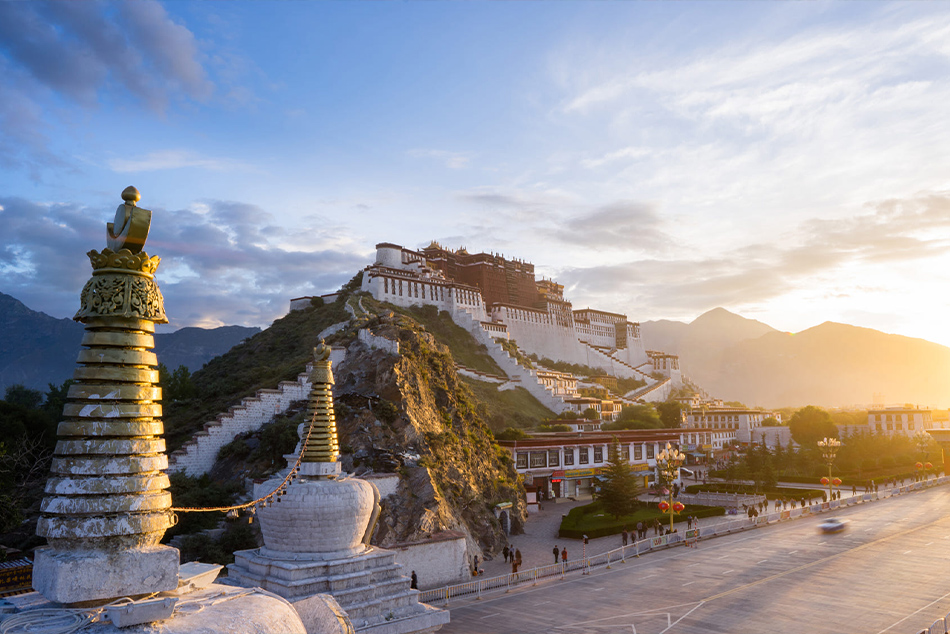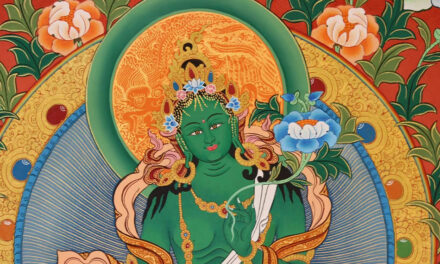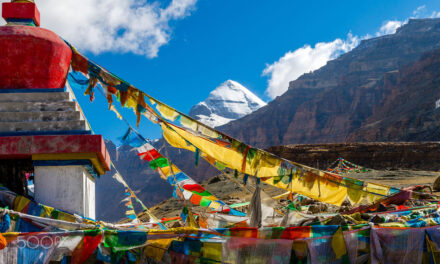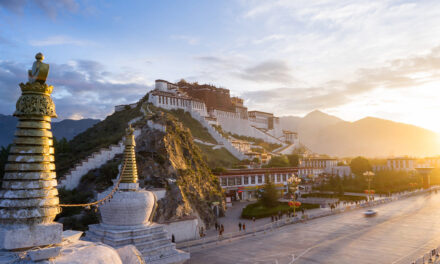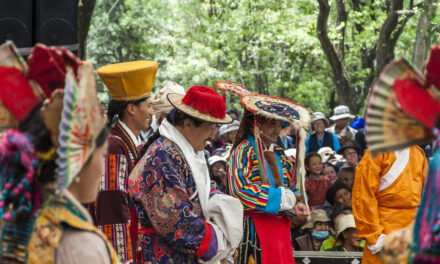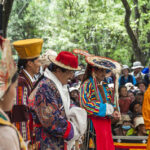Tibetan History and Culture. Tibet, often referred to as the “Land of the Snows,” is a region with a rich tapestry of culture and history. Nestled amidst the Himalayan mountains, Tibet’s unique heritage and traditions have fascinated people from around the world for centuries. In this comprehensive exploration, we will delve into the heart of Tibetan culture and history. From its ancient origins and religious influences to its colorful festivals and unique way of life, Tibet is a land of wonder and intrigue.
The Enigmatic Origins of Tibet
Tibet’s history dates back thousands of years, offering a captivating journey through time and culture. In this section, we will embark on an exploration of the enigmatic origins of Tibet, unravelling the mysteries that shroud its early civilizations and the evolution of its unique cultural identity.
Early Inhabitants and Civilization
The story of Tibet’s origins takes us to a time before recorded history, where ancient inhabitants roamed the vast, pristine landscapes of this high-altitude plateau. These early Tibetans, also known as ‘Zhang Zhung‘ people, were hunter-gatherers who thrived in a land where yaks and wild game provided sustenance. They left behind a legacy, their footprints woven into the very fabric of Tibetan culture.
Despite the scarcity of written records, archaeology has unearthed clues about the prehistoric people of Tibet. Cave paintings, tools, and burial sites offer insights into their daily lives and spiritual beliefs. These early Tibetans practiced animism, worshipping the forces of nature, and their spirituality was intertwined with the land they inhabited.
The legacy of these early inhabitants continues to influence Tibetan culture today. Traditional Tibetan medicine, for instance, is deeply rooted in the ancient knowledge of herbs and natural remedies, a testament to the enduring wisdom of the early Tibetans.
The Unification of Tibet
Tibet’s history took a significant turn with the unification of scattered tribes into a unified region. This marked a pivotal moment in Tibetan history, shaping the trajectory of its future development.
The journey toward unification was neither swift nor without its challenges. It was under the rule of King Songtsen Gampo, who reigned in the 7th century, that Tibet began to evolve from a collection of tribes into a centralized state. King Songtsen Gampo was a visionary leader who played a vital role in laying the foundations of a unified Tibet.
His most renowned contribution was the introduction of Buddhism to Tibet. King Songtsen Gampo recognized the transformative power of this faith, and its arrival marked a turning point in Tibet’s history. With the help of his two influential queens, Princess Wencheng of the Chinese Tang Dynasty and Princess Bhrikuti of Nepal, Buddhism began to shape the spiritual landscape of Tibet. It merged with the indigenous Bon religion, creating a unique Tibetan form of Buddhism that still thrives today.
The unification of Tibet paved the way for a golden era in Tibetan history, with achievements in art, architecture, and spirituality that continue to inspire the world. The Tibetan script, influenced by the ancient Indian Sanskrit, was created during this period, further solidifying Tibet’s cultural identity.
The Influence of Buddhism
The influence of Buddhism in Tibet is a profound and enduring story. With the arrival of Buddhism in the 7th century, Tibet’s spiritual landscape underwent a remarkable transformation.
Tibetans embraced Buddhism with fervor, seeing in it a path to enlightenment and a means to harmonize their lives with the land they cherished. Under the guidance of Padmasambhava, also known as Guru Rinpoche, Buddhism flourished in Tibet. Padmasambhava’s teachings and practices continue to resonate through Tibetan Buddhism to this day.
This profound influence of Buddhism shaped not only the religious but also the cultural, artistic, and social aspects of Tibetan life. Monasteries and temples, like the iconic Jokhang Temple in Lhasa, were constructed, becoming centers of spirituality, art, and education. Buddhist art, with its intricate thangka paintings and sculptures, emerged as a vibrant expression of faith and creativity.
Incorporating Buddhist values into their daily lives, Tibetans began to follow the path of compassion and wisdom, emphasizing harmony with nature and fellow beings. This shift in spiritual focus continues to be a cornerstone of Tibetan culture and identity.
The arrival of Buddhism marked a turning point in Tibet’s history, intertwining the destiny of this high-altitude land with the profound teachings of the Buddha. It set in motion a cultural and spiritual journey that continues to captivate the world.
The Heart of Tibetan Culture
Tibetan culture is a rich and captivating tapestry, woven together from traditions, art, and the daily lives of its people. In this section, we will embark on a journey to uncover the core aspects that define the essence of Tibetan culture, revealing the very heart and soul of this unique heritage.
Language and Writing
The Tibetan script is an intricate and unique form of writing, and it serves as the foundation for preserving the rich history and culture of Tibet. The Tibetan language, derived from ancient scripts, is both fascinating and integral to the Tibetan way of life.
Tibetan writing is an ancient script that traces its origins back to the 7th century when King Songtsen Gampo and his scholars created the Tibetan alphabet. It’s a script that holds a deep connection to Buddhism, reflecting the spiritual importance of written knowledge. Monks and scholars dedicated their lives to meticulously preserving Buddhist scriptures and historical records in this script.
The preservation of the Tibetan language is not merely a matter of words but a custodian of a vibrant culture. In modern Tibet, efforts are made to teach and pass on the language to the younger generation to ensure its continuity. Tibetan schools, both in Tibet and among the Tibetan diaspora, play a crucial role in keeping the language alive, maintaining a strong link to the rich past.
Traditional Clothing and Ornaments
Tibetan clothing and ornaments form a vibrant and intricate world, each element carrying its own unique symbolic significance. The traditional attire of Tibetans is not only a reflection of their heritage but also a testament to the harsh climatic conditions of the region.
One of the most iconic pieces of Tibetan clothing is the ‘chuba,’ a thick robe designed to protect against the biting cold of the Tibetan plateau. It is often adorned with intricate patterns and designs, showcasing the region’s distinctive craftsmanship. The ‘chuba’ is not only practical but also a symbol of Tibetan identity, passed down through generations.
Tibetan jewelry, on the other hand, is an art form in itself. Adorned with coral, turquoise, and silver, these ornaments carry spiritual significance. The use of these materials reflects Tibet’s reverence for nature and its unique relationship with the land. The belief is that these ornaments offer protection and blessings, making them an essential part of Tibetan culture.
Tibetan Cuisine
Tibetan cuisine is a remarkable blend of unique flavors and ingredients, perfectly adapted to the high-altitude environment. Traditional Tibetan dishes often incorporate ingredients like yak meat, barley, and dairy products, reflecting the lifestyle of nomadic herders.
The importance of yak-based foods in Tibetan cuisine cannot be overstated. Yak butter tea, ‘tsampa’ (roasted barley flour), and ‘thukpa’ (noodle soup) are staples in the Tibetan diet. The yak, often referred to as the ‘ship of the plateau,’ provides not only sustenance but also fur for clothing and fuel for heating.
Yak butter tea, in particular, is a quintessential Tibetan beverage. It’s a blend of strong tea, yak butter, and salt, providing the energy and warmth needed to combat the high-altitude cold. This unique drink is an integral part of Tibetan hospitality, often offered to guests as a sign of respect.
Tibetan Architecture
Tibetan architecture is a testament to remarkable craftsmanship and spirituality. The buildings in Tibet, whether monasteries, palaces, or homes, are architectural wonders, reflecting both the region’s climatic conditions and the deeply-rooted spiritual beliefs of its people.
Tibetan monasteries are among the most iconic architectural structures, characterized by their distinctive white walls and golden roofs. The Jokhang Temple in Lhasa, a UNESCO World Heritage site, is a prime example of Tibetan architectural beauty. Its intricate designs and religious significance make it a spiritual epicenter of Tibet.
Traditional Tibetan homes, on the other hand, are designed to withstand the harsh winters. These homes feature thick walls, small windows, and often have prayer flags fluttering on the rooftops. The design is not merely functional but carries a deep spiritual connection, symbolizing protection and well-being for the residents.
In this section, we have touched on the foundational elements of Tibetan culture, from its unique language and writing to the intricate clothing, hearty cuisine, and spiritual architecture. These aspects form the core of Tibetan identity, a tapestry woven over centuries and continuing to thrive in the hearts of its people.
Celebrating Life: Tibetan Festivals
Tibetan festivals are like vibrant brushstrokes on the canvas of life, adding a kaleidoscope of colors and cultural significance to the Tibetan calendar. In this section, we will immerse ourselves in the world of Tibetan festivals, each of which brings a unique flavor to the land of the snow.
Tibetan New Year (Losar)
Losar, the Tibetan New Year, is a time when the entire region comes alive with vibrant festivities. Preparations for this auspicious event begin well in advance, with families and monasteries getting ready for a celebration like no other. The festivities span several days and involve various traditions, from the creation of intricate ‘Rangoli’ designs on doorsteps to the performance of special rituals and pujas in monasteries. One of the key elements of Losar is the preparation of ‘changkol,’ a special drink made from Tibetan barley beer called ‘chang.’ Another interesting tradition is the making of ‘guthuk,’ a unique noodle with hidden ingredients like wool, salt, or coal, believed to reveal one’s personality traits. The celebrations continue for three days, concluding with a heartwarming gathering of family and friends, feasting, and the consumption of the much-anticipated changkol.
Saga Dawa Festival
The Saga Dawa Festival, also known as ‘Qiong Ren Jie’ in Chinese, is one of the most significant events in Tibet, celebrated with deep spiritual reverence. It falls on the fifteenth day of the fourth month and commemorates the life of Buddha Shakyamuni, who was born, attained nirvana, and passed into parinirvana on this day. Tibetans believe that performing acts of generosity during this time will accumulate immense merits. Activities include circumambulation around holy sites, the liberation of animals, chanting and prayer recitals in monasteries, and picnics at scenic spots. It’s a day when Tibetans reach out to those less fortunate, earning it the name ‘Poor People’s Day.’ The Saga Dawa Festival is a unique opportunity to witness the deep spiritual connection between Tibetans and their cultural heritage.
Shoton Festival
Shoton Festival, also known as the Tibetan Opera Festival or the Buddha Exhibition Festival, showcases the cultural richness of Tibet. A prominent feature of this festival is the performance of traditional Tibetan operas at Norbulingka Palace. The operas are a testament to the artistic prowess of Tibetan performers, featuring stories of love, valor, and the Tibetan way of life. In addition to the opera performances, there are exhibitions of Buddha paintings, adding a spiritual dimension to the festivities. It’s a time when Tibetans from all walks of life gather to immerse themselves in art and culture, filling the air with songs, dances, and laughter. Shoton Festival provides a unique window into the artistic heart of Tibet.
Tashilhunpo Monastery Festival
The Tashilhunpo Monastery Festival, also known as the Buddha Exhibition Festival, is a celebration of great historical significance. Held in the middle of the fifth lunar Tibetan month, the festival features the exhibition of different Buddhas over the course of three days. Each day, a different Buddha is unveiled – Buddha Amitabha on the first day, Buddha Shakyamuni on the second day, and Maitreya, the future Buddha, on the third day. These exhibitions serve as powerful reminders to cherish memories of the past, pray for happiness, and aspire to a bright future. The festival reaches its zenith with the unveiling of a colossal, four-storey thangka behind the monastery, followed by Buddhists circumambulating the monastery and sharing barley wine at the square. The Tashilhunpo Monastery Festival is a fusion of spirituality, history, and community.
Tsurphu Cham Dance Festival
The Tsurphu Cham Dance Festival, celebrated on the tenth day of the fourth month in the Tibetan calendar, commemorates the great Indian guru, Padmasambhava. It is a festival with profound religious significance, featuring the Grand Dharma Assembly and Buddha Exhibition, among other religious activities. The Cham dance, unique to Tibetan culture, combines intricate plots, characters, music, and dance. It differs from Tibetan opera and holds a deeper religious meaning. Many Tibetan monasteries have their own Cham groups, each with unique masks, costumes, decorations, and musical instruments. These items are sacred and undergo religious rituals before being used in the dances. The Tsurphu Cham Dance Festival is a captivating celebration of spirituality and artistry that offers a glimpse into the essence of Tibetan Buddhism.
Gyantse Damar Festival
The Gyantse Damar Festival, which began as an athletic competition in the 1400s, has evolved into an inter-village gathering with a mix of sports, entertainment, and cultural festivities. This festival showcases horse and yak races, beautifully decorated horses, horsemen in colorful ethnic attire, wrestling, track and field events, archery competitions, Tibetan opera, singing, and dancing. The event also features numerous businessmen displaying local products and thousands of foreign visitors and journalists. It’s a time when the rich culture and traditions of Tibet shine bright, where both locals and visitors join in the joyous celebrations, highlighting the sense of community and camaraderie that defines Tibetan culture.
Tibetan Fairy Festival (The Women’s Festival)
The Tibetan Fairy Festival, known by various names like the Women’s Festival, Palden Lhamo Festival, Tianmu Festival, or Bailairizhui, heralds the arrival of winter on the plateau. During this unique celebration, women and girls dress up for pilgrimages to temples and present ‘khatas,’ ceremonial silk scarves, to their fairies. An interesting twist to this festival is that women can ask for money from any man they meet, and it is expected that men be generous in their giving. This practice is believed to bring good luck in the coming year. In cities like Lhasa, women may even ask their male colleagues or supervisors to treat them to a grand banquet. Besides these festivities, parents also give money to children as gifts to celebrate a plentiful autumn harvest. Thousands gather at the Jokhang Temple to worship and pay homage to the Protectoress Palden Lhamo and Songtsen Gampo. The Tibetan Fairy Festival encapsulates the nuances of gender traditions and the warmth of community ties.
Great Prayer Festival (Monlam)
The Great Prayer Festival, or Monlam, is held from the fourth to the eleventh day of the first Tibetan month. It was established in 1409 by Lama Tsongkhapa, the founder of the Gelug sect of Tibetan Buddhism. This spiritual celebration sees thousands of monks from the three main monasteries of Drepung, Sera, and Gaden gather at the Jokhang Temple in Lhasa. During Monlam, worshippers congregate to pray, offer donations, and partake in traditional Tibetan Buddhist dances. The festival also hosts debates between lamas and provides a platform for the leaders of Tibetan Buddhism to address the community. Notably, examinations for the Lharampa Geshe degree, the highest degree in Buddhist philosophy in the Gelug tradition, are held during Monlam. The festival is marked by the famous Butterlamp
The Heart of Tibet’s Environment
Tibet, often referred to as the ‘Roof of the World,’ boasts an environment that is as magnificent as it is vital to its culture and history. In this section, we will embark on a journey to understand how Tibet’s awe-inspiring natural landscapes play a pivotal role in shaping its unique way of life.
The Roof of the World
Tibet’s most iconic geographical feature, the Himalayan mountain range, is often hailed as the ‘Roof of the World.’ Stretching across the southern border of Tibet, these colossal peaks stand as a majestic natural barrier between Tibet and the rest of the world. The Himalayas are home to some of the highest peaks on the planet, including the renowned Mount Everest, the world’s tallest mountain. These towering giants are not just geographical wonders but also hold deep cultural and spiritual significance in Tibetan life. They are revered as the abode of deities, and many sacred pilgrimage sites are nestled among these towering summits. The ‘Roof of the World’ is more than a mere geographical reference; it encapsulates the spiritual heights and natural grandeur that are at the heart of Tibetan culture.
Freshwater Resources
Tibet’s vast freshwater resources are the lifeblood of many parts of Asia. The region is the source of numerous major rivers, including the Yangtze, Yellow, Brahmaputra, Mekong, and Indus, which together sustain the livelihoods of millions of people in downstream regions. The intricate network of lakes, rivers, and glaciers in Tibet not only nourishes the arid plains of neighboring countries but also significantly influences the climate of the Asian continent. The freshwater resources of Tibet provide water for drinking, agriculture, and hydroelectric power generation, contributing to the well-being and economic development of countless communities. The purity and abundance of this water are a testament to the pristine nature of Tibet’s environment. Its importance extends far beyond its geographical boundaries, and the protection of these vital water sources is not only a responsibility of Tibetans but also a global concern.
Tibet’s environment is not only a source of sustenance but also a wellspring of inspiration. Its breathtaking landscapes and unique ecosystems have a profound impact on the region’s culture and history, and this intricate relationship is a testament to the deep bond between Tibetans and their natural surroundings.
Dos and Don’ts: Navigating Tibetan Culture
When venturing into the heart of Tibetan culture, it’s crucial to be mindful of the cultural norms that shape this enchanting land. In this section, we will provide a comprehensive guide to the dos and don’ts that will not only ensure a respectful and memorable visit to Tibet but also foster positive interactions with the locals.
Interacting with Locals
In Tibet, respectful communication and interactions hold the key to making your visit truly exceptional. Tibetans are known for their warm hospitality and rich traditions, and it’s essential to approach them with the utmost respect.
Dos:
- Learn Basic Tibetan Phrases: Even if it’s just a simple greeting, making the effort to speak a few words in Tibetan can go a long way in building connections with the locals.
- Ask Before Taking Photos: While Tibet’s landscapes and people are incredibly photogenic, it’s courteous to ask for permission before taking photographs, especially of individuals.
- Smile and Be Approachable: A friendly demeanor can break down barriers and open doors to engaging conversations. Tibetans appreciate warm and welcoming visitors.
- Respect Personal Space: While Tibetans are friendly, it’s crucial to be mindful of personal space, as some individuals may have traditional beliefs about physical contact.
Don’ts:
- Avoid Disrespectful Gestures: Tibetans consider the head to be the most sacred part of the body and the feet the least. Therefore, avoid touching people’s heads and pointing your feet at religious objects or individuals.
- Don’t Discuss Sensitive Topics: Tibetans are known for their peaceful nature, and it’s advisable to avoid discussions related to politics, Tibet’s autonomy, or any sensitive topics. Respectful curiosity is encouraged, but contentious debates are best avoided.
Dining Etiquette
Tibetan cuisine offers a unique and flavorful culinary experience. Exploring this aspect of Tibetan culture is not only delicious but also culturally enriching. Understanding the dining etiquette can enhance your experience.
Dos:
- Accept Offered Food and Drink: It’s polite to accept food or drink offered to you, even if it’s just a small portion. This gesture is a sign of respect and hospitality.
- Use Your Right Hand: When receiving or giving items, particularly during meals, use your right hand, as the left hand is traditionally considered less clean.
- Try Traditional Dishes: Embrace the opportunity to taste traditional Tibetan dishes, particularly those featuring yak meat or dairy products. It’s a fantastic way to connect with the culture.
Don’ts:
- Avoid Wasting Food: In a region where resources can be scarce, it’s essential to avoid wasting food. Consume what you take and appreciate the effort that goes into preparing meals.
- Don’t Criticize or Compare: Refrain from criticizing Tibetan food or making unfavorable comparisons to your home cuisine. Instead, appreciate the unique flavors and ingredients that make Tibetan food special.
Interacting with Elders and Lamas
Respect for elders and lamas is a core value in Tibetan culture. Interactions with these esteemed individuals should be approached with reverence and understanding.
Dos:
- Stand Up When They Enter or Leave: To show respect, it’s customary to stand when an elder or lama enters or leaves a room.
- Answer Clearly: When elders or lamas address you, respond with clarity and respect.
- Remove Your Hat and Bow Slightly: When meeting a lama, it’s polite to remove your hat and bow slightly as a sign of reverence.
- Be Patient and Respectful: Elders and lamas are often filled with wisdom and experiences. Be patient, listen attentively, and show respect for their knowledge.
Don’ts:
- Avoid Sitting with Your Back to Them: It’s considered disrespectful to sit with your back facing elders or lamas. Ensure that your body is oriented respectfully when in their presence.
- Don’t Address Them Directly by Name: Instead, use respectful titles or honorifics when addressing elders or lamas.
- Refrain from Making Unnecessary Contact: Maintain an appropriate level of physical distance when interacting with elders or lamas, particularly if you don’t know them personally.
Navigating the rich tapestry of Tibetan culture can be a profoundly rewarding experience. By following these dos and don’ts, you can ensure that your journey through this remarkable land is not only respectful but also culturally enriching. Engaging with the local customs and traditions with sensitivity and respect is the key to creating lasting memories and fostering positive connections with the people of Tibet.
Conclusion Tibetan History and Culture
Nestled in the heart of the Himalayas, Tibet stands as a testament to the enduring splendor of a culture and history that are deeply intertwined with the breathtaking landscapes that surround it. This is a land where tradition and spirituality intersect in a remarkable tapestry of life, creating an experience that is nothing short of awe-inspiring.
As we conclude our journey through Tibetan culture and history, it’s clear that Tibet is not just a place on the map; it’s a realm of intricate rituals, vibrant festivals, and breathtaking landscapes. It’s a testament to the resilience of a people who have preserved their unique way of life through centuries of change.
To truly appreciate Tibet is to embrace its cultural richness and natural wonders. It’s about venturing into monasteries and palaces that resonate with centuries of prayers and devotion. It’s about wandering through bustling marketplaces and tranquil villages, each revealing a different facet of Tibetan life. It’s about engaging with locals, sharing in their traditions, and forming connections that transcend borders and languages.
In the midst of this remarkable culture, every festival becomes a joyous celebration, every meal a sensory delight, and every interaction a lesson in respect and understanding. The landscape, from the majestic Himalayan peaks to the tranquil lakes and flowing rivers, provides not just a backdrop but the very essence of Tibetan existence.
Tibet’s culture and history are not mere chapters in a history book; they are living, breathing forces that continue to shape the lives of the people who call this land home. To immerse oneself in this world is to witness the beauty of a culture that has endured against the backdrop of a challenging history.
Whether you’re drawn to Tibet for its spiritual significance, its incredible landscapes, or its fascinating cultural traditions, you will find that it is a place where the past is a part of the present and where the land itself seems to whisper the stories of centuries gone by.
In the end, the journey into Tibetan culture and history is not just about exploring a place on Earth; it’s about discovering a profound connection between people and the land, a connection that reminds us of the enduring power of culture and the beauty that thrives in the face of adversity.
So, as you step away from this exploration, remember that Tibet is a place that invites you to not just witness its wonders but to become a part of them. It’s an invitation to embrace a culture and history that are as resilient as the mountains that cradle this remarkable land.
In the words of the great Tibetan proverb, “It’s better to see something once than to hear about it a thousand times.” Tibet is a place where seeing is believing, and your journey into its heart will undoubtedly be a life-changing experience.
FAQs About Tibetan Culture and History
Is Tibet open to tourists?
Absolutely, Tibet is indeed open to tourists. It’s a land that welcomes travelers from around the world to explore its rich cultural tapestry and stunning landscapes. However, it’s important to note that Tibet does have specific travel regulations and permits in place. To ensure a smooth and enjoyable trip, it’s advisable to stay updated on the latest travel requirements and regulations before planning your journey. This way, you can be well-prepared for an unforgettable experience in this unique region.
What is the significance of Tibetan prayer flags?
Tibetan prayer flags are a ubiquitous sight in this enchanting land. These colorful flags, often found strung across mountain passes and in other prominent locations, hold deep spiritual significance. They are not mere decorations but carriers of prayers and mantras to the heavens. As the wind rustles through them, the prayers are released, spreading positive intentions and blessings to all living beings. Tibetan prayer flags are a reflection of the profound spirituality that permeates this culture and the wish for peace and goodwill.
How can I respect local customs during Tibetan festivals?
Respecting local customs during Tibetan festivals is a wonderful way to engage with the culture and its people. Here are some tips to ensure you do so effectively:
- Observation: Start by observing the local customs and traditions. Pay attention to how locals interact and what practices are followed during festivals. This will provide valuable insights into how you can participate respectfully.
- Photography: If you wish to take photographs, it’s courteous to ask for permission before doing so. Some rituals and ceremonies may be considered private or sacred, and it’s essential to respect this.
- Participation: If you’re invited to join in a festival or celebration, do so with enthusiasm and respect. Participate in a manner that aligns with local traditions and customs.
By taking these steps, you can immerse yourself in the festivities and create meaningful connections with the people of Tibet.
What is the importance of yak-based products in Tibetan cuisine?
Yaks hold a central place in Tibetan culture, and their significance extends to cuisine. Yak-based products, including their milk, meat, and fur, are essential to various aspects of Tibetan life.
- Yak Milk: Yak milk is a staple in Tibetan cuisine. It is used to make butter, cheese, and a traditional tea called “po cha.” These dairy products are not only nutritious but also provide warmth and nourishment in the cold Tibetan climate.
- Yak Meat: Yak meat is a key source of protein in the Tibetan diet. It’s used in various dishes, often in combination with hearty grains and vegetables. Yak meat is prized for its flavor and nutrition.
- Yak Fur: Yak fur is used to create clothing and shelter in Tibet. It provides insulation from the harsh cold and is woven into traditional garments like chubas (Tibetan robes) and used to make tents.
In essence, yaks are a lifeline in Tibet, offering sustenance, warmth, and materials for daily life, making them an integral part of Tibetan culture.
How can I visit Tibet in an environmentally responsible manner?
Visiting Tibet in an environmentally responsible manner is crucial to preserving its pristine landscapes and unique ecosystems. Here are some ways to do so:
- Respect Local Environment: Take care not to disturb the local environment. Avoid picking plants, littering, or disturbing wildlife. Many areas in Tibet are ecologically sensitive.
- Support Eco-Friendly Practices: Choose accommodations and tour operators that have environmentally friendly practices. This might include waste recycling, energy conservation, and responsible water use.
- Mindful Waste and Litter: Dispose of your waste properly and recycle whenever possible. It’s essential to keep the region clean and free from litter.
By taking these steps, you can ensure that your visit to Tibet leaves minimal environmental impact while supporting the preservation of this remarkable natural world.
Tibet is a land of wonders, and by respecting its customs and environment, you contribute to its preservation, ensuring that future generations can continue to be captivated by its beauty and cultural richness.

